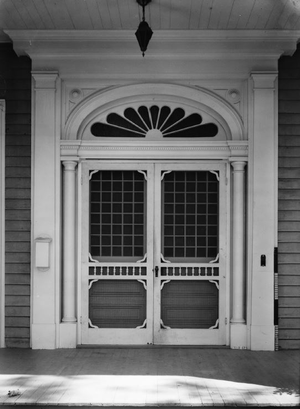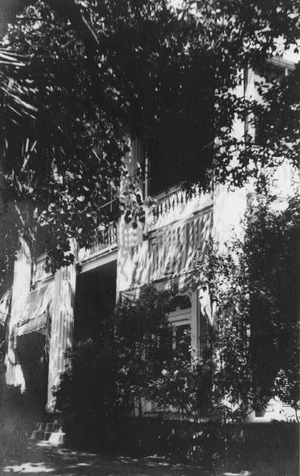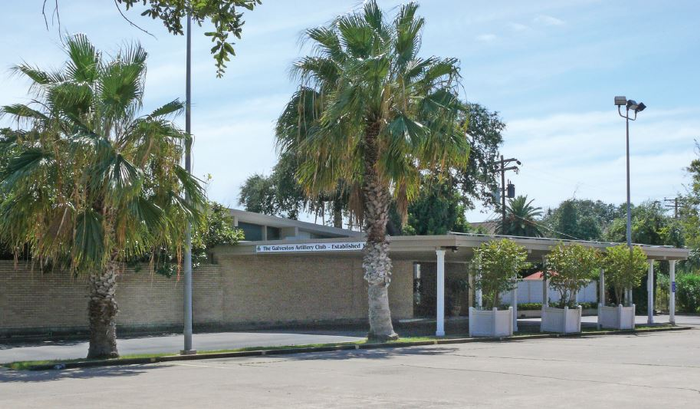Galveston’s private Artillery
Club rests on the site of one of the Island’s
most beloved mansions from the past. Referred to by the Library of Congress as
the Brown-Denson-Moore House, the architectural gem housed even more families
and stories than the title suggests.
Guy Morrison Bryan, the illustrious nephew of
Stephen F. Austin and former member of the U.S. House of Representatives,
purchased the property in 1860 from J. Brown to build a home near local family
members that included the Ballinger family. Originally a 10-acre tract, the lot
extended from 31st to 32nd Streets, between Avenues N and
O.
The two story, Greek Revival style home was
constructed of long-leaf yellow pine from Louisiana. Its old Southern style appearance
with tall columns, broad galleries, and tetrastyle hipped roof was considered
one of the most beautiful designs on the Island
for generations. Visitors often admired the craftsmanship of the delicately
railed second floor balustrade and elliptical fanlight over the front door.
The house was deeply set back in generous,
well-kept lawns and surrounded by lush plantings, including imposing oak trees
from which the home obtained its name “Oakleigh.” Inside,
the walls and ceilings of broad halls and spacious rooms were covered in highly
polished natural woods.
The entrance hall featured an attractive
fireplace of fumed oak with green-toned accents. Mantles, stairways, and
corners throughout the home were accented with potted palms and ferns. Numerous
rooms included the east white reception room, dining room, multiple parlors and
bedrooms, den, conservatory, and library.
Guy and his wife Laura Jack Bryan lived in
the spacious residence until business during the Civil War required their
presence in other locations. Though they returned immediately after the war, Bryan moved his ranch to
the mainland in 1867 and rented out the house.
In November 1871, he moved back to his Island
home with his young family. Laura gave birth to their youngest son in the house
on New Year’s Day 1872 but passed away from heart complications hours later.
Heart-broken, Bryan
and his five children moved in with his brother-in-law Judge Ballinger and sold
Oakleigh.
Pioneer Galveston
businessman Henry Martyn Trueheart, Sr. purchased the large home for his
growing family. He also leased the adjoining property west to 33rd Street
and maintained an orchard with many varieties of fruit and nut trees and
planted an avenue of pines.
He was listed as living at this address on
the 1880 census with his wife Annie VanMeter Cunningham Trueheart, three of
their children, and four live-in servants. During their years spent in the home
they added three more children to their family.
In 1886, the Truehearts moved into a grand
new mansion on Broadway designed specifically for them. (Details about this
home were featured in the February 2019 issue of Galveston Monthly.) Trueheart
sold Oakleigh to William B. Denson, a local attorney with offices at 2205 Strand. It was during the twelve years he resided there
with his wife Mary and two daughters that the house became known as the “Old
Denson Home.” A respected lawyer, Denson was also active in the community,
served on the school board, and was a deacon at the First Baptist
Church.
The most lively and social years of
Oakleigh’s existence undeniably began in 1898 when it was purchased by Thomas
Jared Groce, a banker and descendant of a highly respected Texas pioneer
family. He and his wife Clifford Loverin Groce were renowned for their lavish
yet light-hearted parties that were thrown year-round.
Entertaining became a way of life at the
large home, which provided ample space for the Groce’s large guest lists. In
addition to friends and family, they often entertained visiting dignitaries and
servicemen from various countries.
At the time of the 1900 Storm, the couple
lived at Oakleigh with their daughter Patience, sons Benton and Browning, and
five live-in servants. No mention was made in the local papers of any damage to
the large wooden structure, but Groce actively served on several committees to
revitalize Galveston
after the tragic disaster.
In 1905, the Groces were back to their
tradition of sharing celebrations with friends and hosted their own 25th
anniversary party with over 500 guests. In keeping with the family’s love of
music, the theme was a garden musicale. Local musicians were hired, and strains
of music floated out into the gardens through tall, French walk-through windows
that were left open during the party.
A pianist performed in the drawing room;
bridge, jigsaw puzzles, and assorted games were enjoyed in the library. A
minstrel orchestra played in the hall to provide music for dancing, and the
gardens provided moonlight strolls to enjoy the flowers. Professor Conway
Shaw’s orchestra played outside on the grounds, where a pergola with wisteria
entwined columns, a rose garden with antique sun dial, and beds of dahlias
created an enchanting backdrop for the gathering.
 In 1911, Galveston National Bank, which Groce
had successfully led for years, merged with City National Bank owned by the
Moody family. The banker was intensely worried that this merger would lead to
litigation and the loss of a large deal of his own money.
In 1911, Galveston National Bank, which Groce
had successfully led for years, merged with City National Bank owned by the
Moody family. The banker was intensely worried that this merger would lead to
litigation and the loss of a large deal of his own money.
T. J. Groce died of a cerebral hemorrhage on
August 2, the day before an ad ran in the local newspapers announcing the
consolidation of the banks, with his son Browning’s name signed as
Vice-President of the former institution. Distraught at the loss of his father,
Browning committed suicide the next day at his home at 1501 31st Street. The Harvard
graduate had only been married two years.
Over the course of the following year, a
trial was held concerning actions taken by the elder Groce two days before his
death that resulted in the movement of the bank’s funds. A letter handwritten
by the former banker was found and utilized to clarify and settle the case.
Despite the chaos of her surroundings, Mrs. Groce continued to receive visitors
on “Visiting Thursday” at her home, but the days of extravagant parties were
gone.
She was an active member of the music
committee at Trinity Episcopal Church and was involved in the decision to
purchase a $10,000 organ for the church in 1912. The Groce’s son Benton died of
typhoid fever two years later. After so much tragedy, Clifford and her daughter
Patience moved to California
where they spent the rest of their lives.
 Bartlett Doe Moore, President of Moore Lumber
Company and Texas Nail and Wire Manufacturing, purchased Oakleigh from Groce’s
widow in April 1914 for $22,500. Moore’s
wife Frances was a member of the Hutchings family. The couple lived in the home
with their four children, Frances’
mother and sister, one servant, and a black cocker spaniel named Skipper.
Bartlett Doe Moore, President of Moore Lumber
Company and Texas Nail and Wire Manufacturing, purchased Oakleigh from Groce’s
widow in April 1914 for $22,500. Moore’s
wife Frances was a member of the Hutchings family. The couple lived in the home
with their four children, Frances’
mother and sister, one servant, and a black cocker spaniel named Skipper.
Luckily for natives and visitors, during the
years in which the home was occupied by the Moore family, this beautiful residence was
featured on numerous homes tours, including one during the Oleander Fete in
1940.
The house remained in the Moore
family until several years after Bartlett’s
death in 1943. The Moore
children had married, except for their middle son who died during World War II
the year following his father’s death. At some point during the Moore ownership, screens were installed between the columns to enclose its
porches. When Frances Moore decided it was time to move into a smaller home,
the era of Southern graciousness on the corner of Avenue O and 33rd
had ended.
 Having historic landmark status unfortunately
could not save Oakleigh from the wrecking ball. Demolition of the stately
mansion began in May 1957 to make way for a new clubhouse for the Galveston
Artillery Club. The new building was erected among an existing grove of trees,
and two rare palms were relocated on the property to make room for a swimming
pool. Because of this approach during construction, the lot still maintains its
seclusion from view thanks to the dense plantings that were initiated years
ago.
Having historic landmark status unfortunately
could not save Oakleigh from the wrecking ball. Demolition of the stately
mansion began in May 1957 to make way for a new clubhouse for the Galveston
Artillery Club. The new building was erected among an existing grove of trees,
and two rare palms were relocated on the property to make room for a swimming
pool. Because of this approach during construction, the lot still maintains its
seclusion from view thanks to the dense plantings that were initiated years
ago.
Though Oakleigh is only a
memory, current members of the Artillery now stroll the grounds beside trees
that sheltered parties during the Victorian era.